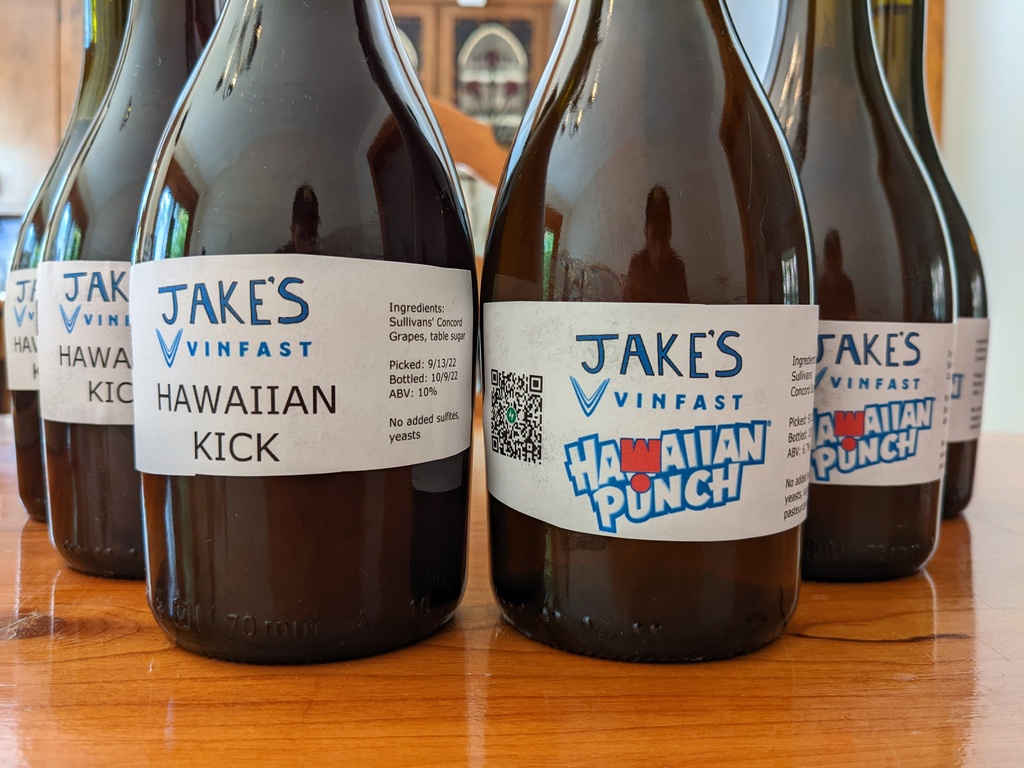This is an attempt to reproduce last year’s concord grape wine which was possibly one of the best homebrews I have made, albeit in a small quantity. Last year I used store-bought yeast, but this time I’m skipping the yeast and letting it naturally ferment. The concord grapes start out as delicious candy, which ferments into a beautiful pink color with a delightful tart flavor, just begging to be carbonated and enjoyed.
9/13/22
J & K had another amazing year of concord grapes in their backyard and invited me back to share. We filled up a large shopping bag with bunches of freshly picked grapes, and brought them home.
I carefully cleaned but didn’t thoroughly sterilize anything besides some quick sprays with Star San. I figure that because I’m using raw grapes and no campden tablets to sanitize, there will be a significant amount of un-sterileness anyway. I removed the ripe grapes from stems and put them in a giant metal bowl. The grapes filled the bowl. Then I squeezed the grapes by hand in the bowl, and repeatedly smashed them to the bottom with the palm of my hand.
I used a mesh strainer bag to strain and squeeze the liquid, in several batches, into a spaghetti pot. I poured the liquid through a straining funnel into a 1-gallon jug.
The juice filled the jug, after which I added a sterilized airlock. I put it in the upstairs closet to (hopefully) ferment. I didn’t have any yeast, so hopefully the natural yeast will ferment it on its own.
9/15/22
The concord grape juice is bubbling. Yay! That means the natural fermentation is working well.
9/22/22
The jugs are fermenting vigorously! The thermometer on the glass jug reads 75 degrees, which seems warmer than the actual house. 2 days ago it read more like 72 degrees.
9/23/22
Temperatures have cooled some, and the fermentation slowed down so I decided to transfer to a mini keg. I star-san’d the autosiphon and a mini keg, put some c02 into the mini keg, and then siphoned the liquid off the sediment in the carboy to the mini keg. I had a little taste, which tasted great. (I also tasted some strained sediment, and that was a bit gross, and probably would be a source of off-flavors if I kept it on there for too long).
Boy this stuff looks a lot like Trillium Brewing’s “Fated Farmer Concord Grape”, 7.4%, Barrel Fermented Wild Ale (the below photo was in early 2022, on the menu for $9 for 10oz),. Trillium describes the process of making this as, “The grist of each of the dynamic Fated Farmer wild ales is set on the structure of Valley Malt and is barrel fermented in 500L puncheons with our Native New England Wild Culture and aged for 5-7 months, before refermenting on freshly harvested fruit.”:
The flavor of raw concord grape is so fantastic. Here’s an idea for next year. Maybe it would make sense to use this as an additive to a 5-gallon batch of cider to give it interesting flavor and color.
10/4/22
The mini keg has been stable for a week or so in that it is not generating any additional pressure so I think it has finished fementing. I brought the mini keg downstairs to start carbonating in the fridge with a mini co2 tank and regulator. Meanwhile I poured a glass.
It looks a little bit cloudy and dark, but has a ruby red grapefruit coloring and a pleasant concord grape aroma. The taste is like if Jolly Rancher made a very dry wine. It doesn't exactly put hair on your chest, and yet it packs a punch. Albeit a slightly Hawaiian Punch, which is fitting because J (the producer of these grapes) is in Hawaii right now preparing for the Iron Man world championships. I love that it consists only of grapes fermented naturally. The fact the process allowed these grapes to become the fermented version of themselves and it came out as good as it did makes this a big win for this minimalist approach to making wine!
10/9/22
I transferred the wine, or "Hawaiian Punch", directly from the keg into bottles using a small picnic tap with a hard plastic tube attached.

